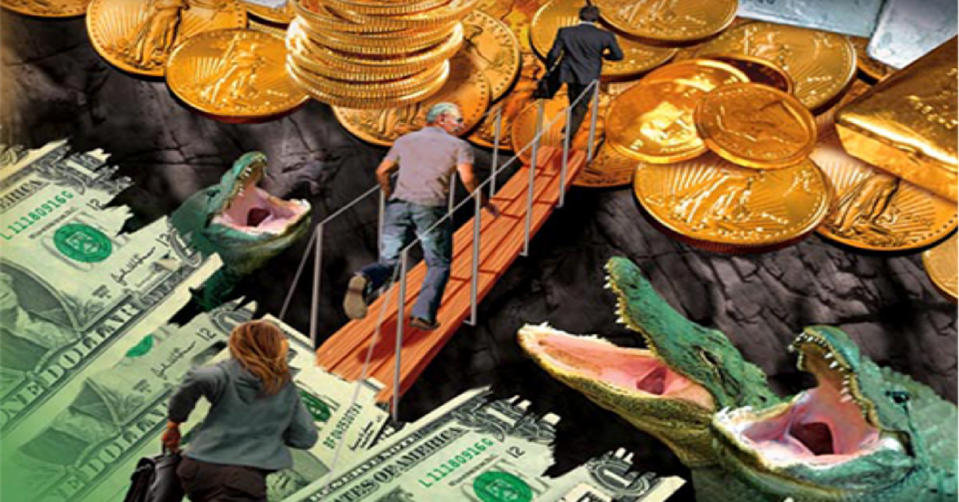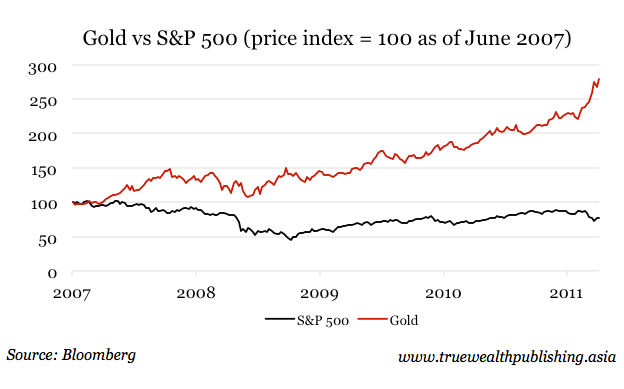Here’s why the conventional wisdom on gold is right

In the world of investing, there is a lot of conventional “wisdom”. These are ideas so accepted they go unquestioned. But conventional thinking is often wrong. Take the idea of diversification, for instance. The cliché is “Don’t put all your eggs in one basket.” Is this good advice for everyone? Not necessarily, according to investing legend Jim Rogers. And viewing diversification strictly in terms of asset allocation – rather than a function of your “personal equity” – is maybe even more dangerous. Another bit of conventional wisdom is that investors should follow their investments closely – watching prices like a hawk, tracking the latest news and developments. However, fixating on the “noise” in your portfolio can lead to bad and emotional decisions. And here’s another bit of conventional investing wisdom we often hear (from me as well): In times of panic, gold is a safe haven. Gold in your portfolio can help insure against losses when the stock market falls. As it turns out, this is one piece of conventional wisdom that’s correct. A recent study proved it. Precious metals are safe havens Two researchers in Ireland recently wrote a paper entitled Reassessing the Role of Precious Metals As Safe Havens – What Colour Is Your Haven and Why? They conclude that relative to many other assets, and in many countries, precious metals – including gold – act as safe havens in turbulent markets. The researchers found that precious metals can indeed be portfolio “insurance” against unexpected events or “fat tail risk”. Fat tails are statistically rare events with bad consequences – like a hundred-year flood, or a once-in-a decade market crash, for instance. Even worse are Black Swans – catastrophic events with no precedence. Because they’ve never happened before, they blindside investors, causing extreme losses. Especially during times of stress, gold marches to its own drummer The researchers confirmed that gold is generally uncorrelated with most other financial assets. Correlation refers to the degree assets or securities have similar price moves. When two assets have a positive correlation (approaching 1), their prices tend to move in the same direction at about the same time. When assets have a negative correlation (approaching -1), they tend to move in opposite directions. A correlation close to zero means two assets move independently. As you can see in the chart below, gold’s correlation with other assets is very low. That’s exactly why gold works so well in a portfolio when markets are weak.

The researchers’ work confirms decades of academic research that gold and the other precious metals are uncorrelated both during normal times and during times of economic and market stress. Gold is a hedge – its price doesn’t usually follow other assets during normal times. It is also a safe haven – during abnormal times, when the prices of other assets crash, precious metals tend to rise. Political uncertainty fuels the gold market The researchers studied different kinds of economic and market events that cause precious metals to become safe havens. They identified three general types of market stress indicators: financial market stress, political stress and consumer sentiment. They found that political and policy risk is “a positive and robust determinant across countries when precious metals are safe havens against stock and bond markets tail events.” In other words, in the many countries studied, precious metals tend to rise the most – offering the strongest safe haven protection – during market distress triggered by government policy uncertainty. Both last year’s Brexit and the 2007-2008 global economic crisis are recent reminders of the value that gold holds during economic earthquakes. Last June, Britain’s vote to exit the European Union caused unexpected, extreme economic policy uncertainty. On June 24, 2016, the day after the surprise vote, London's FTSE 100 fell 12.5 percent, German DAX skidded 6.8 percent, the broad Stoxx Europe 600 index fell 7 percent and France's CAC 40 was off 8 percent. Meanwhile gold was UP 5 percent. During the global economic crisis, gold was also a safe haven. From June 2007, when the financial crisis first broke, to the March 2009 bottom, the U.S. Dow Jones Industrials dropped about 45 percent. Many global stocks markets were down over 50 percent. However, during that period, the price of gold rose from about US$670 to US$938, for a gain of about 40 percent, as shown below.

The winning metals You might be surprised to learn that while gold, silver, platinum and palladium all typically provided safe havens against severe market declines, silver was often a better safe haven than gold. According to the researchers, in many countries, silver has been the best safe haven against stock and bond market falls, followed by palladium, then gold and platinum. As we’ve written before, when gold goes up, silver tends to rise even more. Likewise, when gold declines, silver tends to fall more. (Not long ago we wrote a special report about investing in silver that you can access… here.) We’ve discussed both platinum and palladium in the past. These metals also provide safe haven during turbulent times. However, given their easy accessibility and superior liquidity, gold and silver are probably the better options for most investors. Why gold is golden during periods of uncertainty While this paper establishes that precious metals have been a good place to park your money during turbulent times, it doesn’t address why this should be the case. Why aren’t – say – oil or wheat safe haven assets? The main reason for this is that physical gold has been used as a currency for thousands of years – whereas paper, or “fiat money,” is a historically recent experiment. In 1971, the U.S. abandoned the gold standard – the last country to do so. Since then, all global currencies are backed by nothing more than faith in the government that prints the money. Thus, when there’s heightened uncertainty about global economic policy, and faith in government falls, gold as the unofficial world currency rises. Contrary to paper currencies, gold is a tangible asset which cannot be printed or destroyed. To use yet another saying that is (true) conventional wisdom, gold is a “currency of last resort.” As we wrote about recently, fear among investors has recently hit all-time lows. This is in sharp contrast to rising uncertainty related to economic policy in the world. Now is a good time to purchase some gold insurance for your portfolio. This latest piece of research confirms what wise investors have known for hundreds of years: In times of trouble, precious metals are safe havens. (In the latest issue of the Asia Alpha Advisory – which was released yesterday – I delve into gold… and talk about two ways to invest in gold. One of them even allows investors to buy gold at a discount to its market price. If you’re not a subscriber, click here to learn more.)

 Yahoo Finance
Yahoo Finance 
